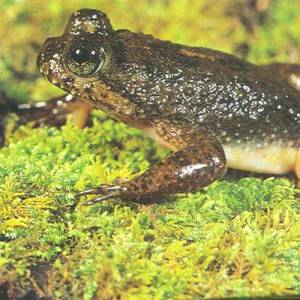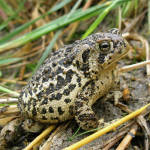Conondale Gastric-brooding Frog
Extinct circa 1983 CE • Blackdall and Conondale Ranges in southeastern Queensland, Australia
"Fertilised eggs or early stage of larvae were presumably swallowed by the female and complete their development in the stomach (gastric-brooding). . . . The production of hydrochloric acid (digestive secretion) in the stomach of the female is ceased by hormones produce by the young. The entire digestive system shuts down, which prevents the digestion of the young. The colourless tadpoles develop in a manner similar to the aquatic tadpoles of other frog species though. They feed of egg yolk. . . . After 6-7 weeks the females give birth to up to 25 young, birth is accomplished by the female widely opening her mouth and dilating her gullet (oesophagus). The young are propelled from the stomach to the mouth, and than hop away. They emerge from the female's mouth as fully former frogs and after 4 days the digestive tract of the female returns to normal and she recommences feeding. . . . The last known individual died in captivity in a laboratory in November 1983."
Peter Maas, "Recently Extinct Animals - Species Info - Southern Gastric-brooding Frog," PeterMaas.nl, July 18, 2004, Web.
Image: Southern Gastric-brooding Frog (Rheobatrachus Silus), Digital image, Web.


Learn about Maya Lin’s fifth and final memorial: a multi-platform science based artwork that presents an ecological history of our world - past, present, and future.

Discover ecological histories and stories of former abundance, loss, and recovery on the map of memory.

Learn how we can reduce our emissions and protect and restore species and habitats – around the world.

See how art can help us rethink the problems we face, and give us hope that each one of us can make a difference.

Help make a global memorial something personal and close to home. Share your stories of the natural world.


